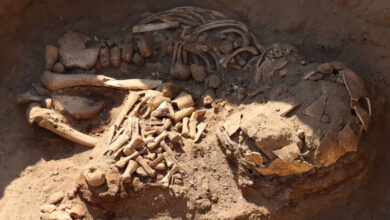This Prehistoric Ocean Was Thalassophobia On Steroids

There are many reasons why you might feel more comfortable being abandoned on land than at sea. As you explore the depths of the ocean, life becomes more terrifying, a phenomenon that is common throughout history.
Every period has one or two sea creatures that are scarier than anything on land. A documentary, “Sea Monsters”, listed the 10 most dangerous seas or oceans of all time. Among them are the Jurassic Sea with its giant pliosaurs, the Prazo Sea with its giant cephalopods and sea beetles, and the Azoic Sea with the largest sharks of all time. However, nothing compares to “Hell’s Aquarium” – the Western Inland Sea, which existed during the Late Cretaceous, full of giant sea creatures.

The Western Interior Sea existed from the Early Cretaceous period about 100 million years ago to the Early Paleocene period 66 million years ago, dividing North America into two continents, Lamyia and Appalachia. At its peak, from 83.6 to 72.1 million years ago, the sea was warm and shallow, measuring 600 km wide and 3,200 km long, and only about 900 m deep.
In this environment, giant sharks and marine lizards dominated. Mosasaurs were the most prominent marine animals, with their enormous size and sharp teeth. Species such as Clidastes, Platecarpus, and Tylosaurus were the most common, with Tylosaurus being the largest and most fearsome, measuring up to 52 ft and having powerful teeth.
In addition to mosasaurs, there was Dinosuchus, a giant crocodile that could reach 39 ft in length and had a bite more powerful than that of a T-Rex. Other marine creatures such as cephalopods also live in these waters, with terrifying sizes and diversity, such as the Tuso Tois and Anko Tois.

Another creature is the Parapuzosia, a giant ammonite with a powerful spiral shell that can grow to 18 m long and weigh over 1.5 tons. These creatures, along with others, make the Western Inland Sea a very scary place for anyone who wants to swim.
In the Western Interior Seaway, ancient sharks and crocodilians were major predators, creating a terrifying aquatic world. Although not all sharks were lethal, some, like the giant *Tycotous*, were specialized in crushing hard-shelled prey with their flat, plate-like teeth. *Carcharocles* or the “Ginsu shark,” a fierce predator resembling a great white, was known for its aggressive diet, including other marine predators. This shark could reach speeds of 70 km/h and had razor-sharp teeth for devastating attacks.

Another formidable predator was the *Squalorax*, or “Crow shark,” which, though smaller, was a fierce hunter of both marine life and flying reptiles. It preyed on large pterosaurs and fish, using its serrated teeth for cutting through tough tissues.
The *Xiphactinus*, a large, bony fish, was infamous for its terrifying appearance and ability to swallow prey whole. It was an effective predator, capable of consuming sizable animals in a single gulp.\

Plesiosaurs, with their long necks and flippers, were less aggressive but highly specialized for ambushing small prey. They used their necks to deceive and trap fish and other small creatures.
The Seaway’s ecosystem began to decline due to environmental changes and the catastrophic asteroid impact 66 million years ago, which led to the extinction of many sea monsters. However, new and bizarre marine creatures continued to evolve in the post-Seaway waters.








